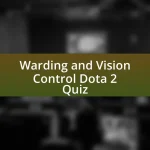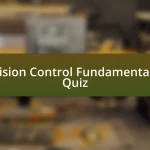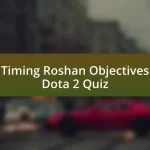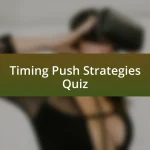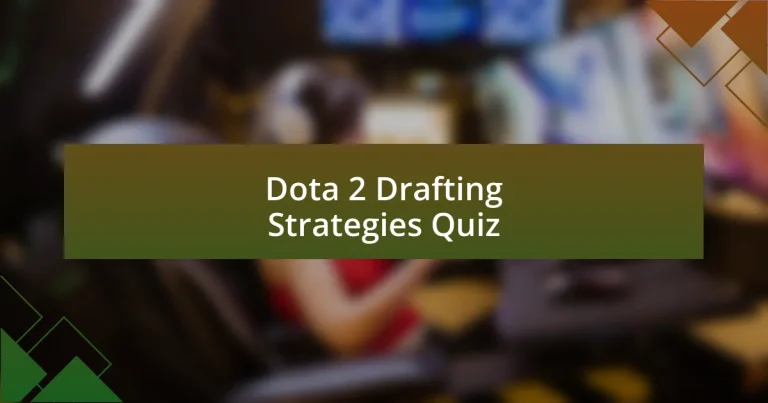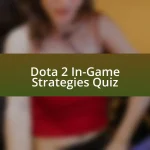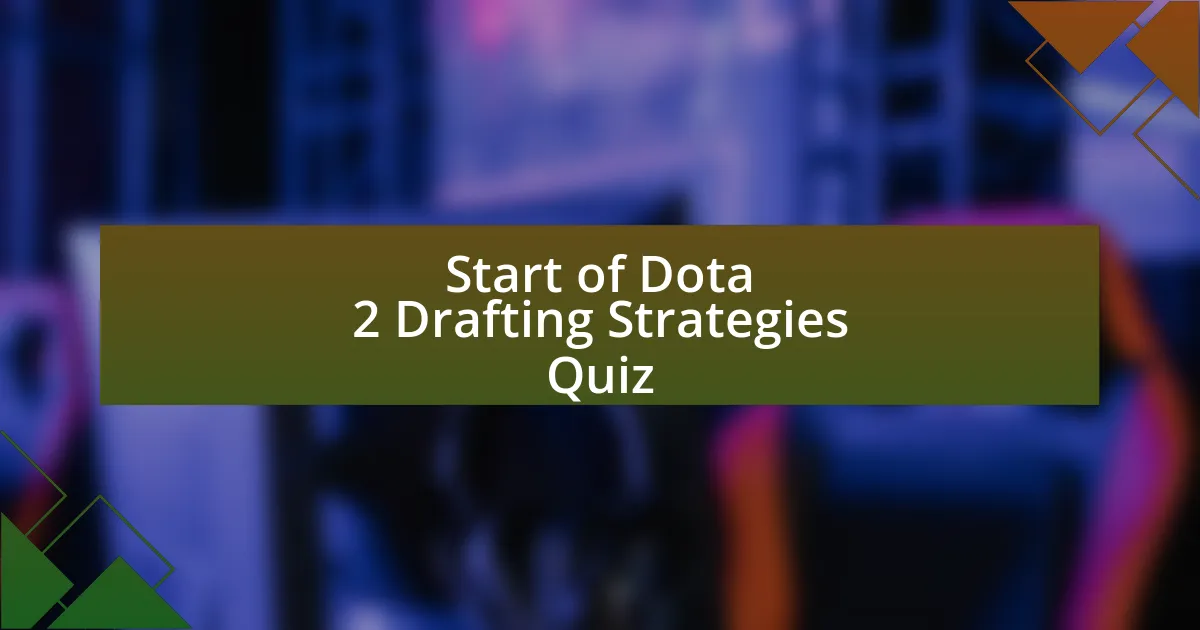
Start of Dota 2 Drafting Strategies Quiz
1. What is drafting in Dota 2?
- Drafting in Dota 2 means picking 5 heroes that fit well together.
- Drafting in Dota 2 involves creating maps for the game.
- Drafting in Dota 2 is about scheduling matches with players.
- Drafting in Dota 2 refers to picking items during gameplay.
2. Why are picks so important in Dota 2?
- Picks are important for deciding the game`s duration and ending.
- Picks are important to identify the strongest players on each team.
- Picks are important because they determine the team`s strategy and synergy.
- Picks are important to establish who plays which role in the game.
3. What are the basic roles in Dota 2?
- Tanks, assassins, scouts, brawlers
- Supports, offlaners, midlaners, hard carries
- Dancers, archers, mages, rogues
- Mages, warriors, healers, summoners
4. How do you pick heroes for each role?
- You pick heroes based on their cosmetic items and skins available.
- You pick heroes based on their abilities and how they synergize with other heroes.
- You pick heroes based on their popularity and current patches.
- You pick heroes based on their visual designs and lore backgrounds.
5. What is synergy in Dota 2?
- Synergy means only focusing on individual hero strengths.
- Synergy is about picking heroes randomly without strategy.
- Synergy refers to combining hero abilities and spells to win lanes, team fights, or the game.
- Synergy involves selecting heroes based on popularity alone.
6. How do you bait your picks in Dota 2?
- You bait your picks by showing all your heroes early on.
- You bait your picks by picking random heroes without strategy.
- You bait your picks by making your opponents unsure, then surprising them.
- You bait your picks by ignoring the enemy`s picks completely.
7. What are the first picks in the drafting phase?
- Assassins
- Supports
- Melee carries
- Tanks
8. Why do you ban heroes in the second ban stage?
- You ban heroes to guarantee a win in the first phase of drafting.
- You ban heroes to hinder the opposition`s plans and to counter their strategy.
- You ban heroes to waste the enemy`s time and disrupt their focus.
- You ban heroes to protect your own picks and secure strong options.
9. What are some common mistakes in drafting heroes?
- Picking overly strong heroes
- Choosing heroes with no synergy
- Having a centralized strategy
- Ignoring enemy team compositions
10. How do you make final picks in the drafting phase?
- You make your final picks that worry the enemy team.
- You only pick heroes that you have previously played.
- You select heroes based on their popularity among players.
- You choose heroes that are already banned by the enemy.
11. What is the importance of banning strong counters?
- Banning strong counters allows players to experiment with new strategies.
- Banning strong counters helps to protect your heroes and strategy.
- Banning strong counters increases the number of heroes available to pick.
- Banning strong counters confuses your opponents about their picks.
12. What is the role of a jungler in Dota 2?
- A jungler only defends the base and does not engage in other activities.
- A jungler helps to farm creeps and roam to other lanes to influence the game.
- A jungler primarily focuses on pushing towers and gaining map control.
- A jungler acts as the primary carry, dealing most of the team`s damage.
13. What are the different types of tri-lanes in Dota 2?
- Offensive and retreating tri-lanes
- Defensive and aggressive tri-lanes
- Static and mobile tri-lanes
- Normal and complex tri-lanes
14. How do you set up your lanes for maximum effectiveness?
- You set up your lanes based on the enemy team`s strategy and your team`s strengths.
- You set up your lanes by choosing heroes with high health only.
- You set up your lanes randomly to confuse your opponents.
- You set up your lanes to ensure all heroes are in one lane.
15. What is the significance of the first round of bans?
- The first round of bans helps to limit the enemy team`s options and gives you an advantage.
- The first round of bans determines the overall match winner before it starts.
- The first round of bans is only necessary in the second part of the game.
- The first round of bans allows players to select random heroes without restrictions.
16. How do you make response picks during the drafting phase?
- You make response picks after the draft is completed.
- You make response picks regardless of the enemy team`s strategy.
- You make response picks exclusively based on your favorite heroes.
- You make response picks based on the enemy team`s picks and your team`s needs.
17. What is the importance of coordination in Captain`s Mode?
- Coordination is vital for team success in Captain`s Mode.
- Coordination is unnecessary for drafting heroes.
- Coordination only matters in ranked matches.
- Coordination is only about communication.
18. How do you handle counterpicks in the drafting phase?
- You ignore the enemy picks and focus only on your heroes.
- You handle counterpicks by banning strong counters and making picks that counter the enemy team`s strategy.
- You only ban heroes that are commonly picked by opponents.
- You always pick the strongest heroes regardless of the enemy.
19. What are some common formations in Dota 2?
- Common formations include double mid, backdoor play, and split carry.
- Common formations include base retreat, jungle control, and random picks.
- Common formations include defensive tri-lanes, aggressive tri-lanes, and solo laners.
- Common formations include mid push, late stack, and nearby fights.
20. How do you maximize early farm in Dota 2?
- You maximize early farm by picking heroes with low mobility and high cost.
- You maximize early farm by always farming the jungle and ignoring lanes.
- You maximize early farm by avoiding fights and sticking to your lane.
- You maximize early farm by using heroes like junglers and ancient stackers.
21. What is the role of a midlaner in Dota 2?
- A midlaner focuses solely on farming without impacting team fights.
- A midlaner only defends the base and does not rotate to other lanes.
- A midlaner strictly supports the offlaner and never engages directly.
- A midlaner deals damage and controls the midlane, often initiating team fights.
22. How do you pick heroes for a defensive tri-lane?
- You pick heroes that are all aggressive and focus on killing quickly.
- You pick heroes that can farm safely and provide vision, such as supports and defensive carries.
- You pick heroes that can only farm and ignore team fight capabilities.
- You pick any heroes without considering their synergy and roles.
23. What are some examples of tight rope carries in Dota 2?
- Techies
- Pugna
- Chaos Knight
- Phantom Assassin
24. How do you prolong the game with your drafting strategy?
- You draft only high-damage heroes for quick kills.
- You select heroes that have weak abilities and synergy.
- You ban all enemy heroes without a strategy.
- You pick heroes that can sustain damage over time.
25. What is the significance of the second round of bans?
- The second round of bans helps to further limit the enemy team`s options and solidify your strategy.
- The second round of bans allows players to switch roles with no restrictions.
- The second round of bans is solely for protecting the weaker heroes from being picked.
- The second round of bans introduces new heroes to the game for the first time.
26. How do you make personal picks and bans during the drafting phase?
- You only pick the strongest heroes regardless of synergy.
- You make personal picks and bans based on your team`s needs and your own playstyle.
- You choose random heroes without strategy or communication.
- You make picks solely based on enemy picks and ignore your team.
27. What are some common mistakes to avoid in drafting heroes?
- Picking all melee heroes
- Choosing strong heroes only
- Ignoring synergy
- Centralized strategies
28. How do you handle steals during the drafting phase?
- You always pick the same heroes regardless of what the enemy chooses.
- You handle steals by being aware of the enemy team`s picks and making strategic decisions to counter their strategy.
- You let your teammates make all the decisions and don’t intervene.
- You ignore steals and focus only on your own picks to win.
29. What is the importance of synergy in your drafting strategy?
- Synergy only matters for late-game strategy, not early picks.
- Synergy is crucial as it allows your heroes to work together effectively to achieve victory.
- Synergy only influences hero appearance and not their abilities.
- Synergy is unimportant and does not impact team performance.
30. How do you set up your lineup for maximum effectiveness?
- You set up your lineup based on the enemy team`s strategy and your team`s strengths, ensuring good synergy among your heroes.
- You choose heroes randomly without considering enemy picks or synergy.
- You select only the strongest heroes available without team composition.
- You rely on a single hero to carry the entire game regardless of team makeup.
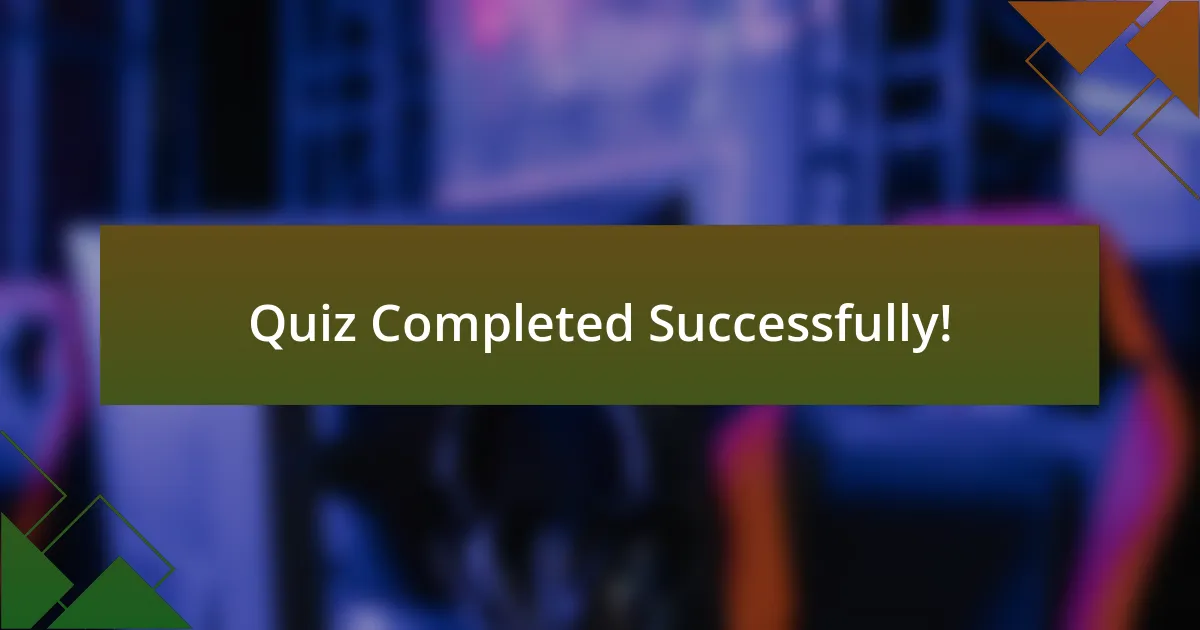
Quiz Completed Successfully!
Congratulations on completing the quiz on Dota 2 Drafting Strategies! We hope you found it engaging and informative. Understanding how to draft effectively can significantly improve your gameplay and help you develop a winning team composition. By reflecting on various strategies, you’ve gathered insights that could enhance your decision-making in matches.
This quiz likely reinforced key concepts about hero roles, synergy, and counter-picking. You may have discovered the importance of flexibility in drafting and the need to adapt to your opponents’ picks. Each question aimed to deepen your understanding of how small adjustments can lead to much larger advantages during the game.
If you’re eager to expand your knowledge further, we invite you to check out the next section on this page. Here, you’ll find detailed information on Dota 2 Drafting Strategies, covering advanced techniques, common pitfalls, and pro tips. Deepening your understanding will empower you to make smarter drafting choices in future games. Happy learning!
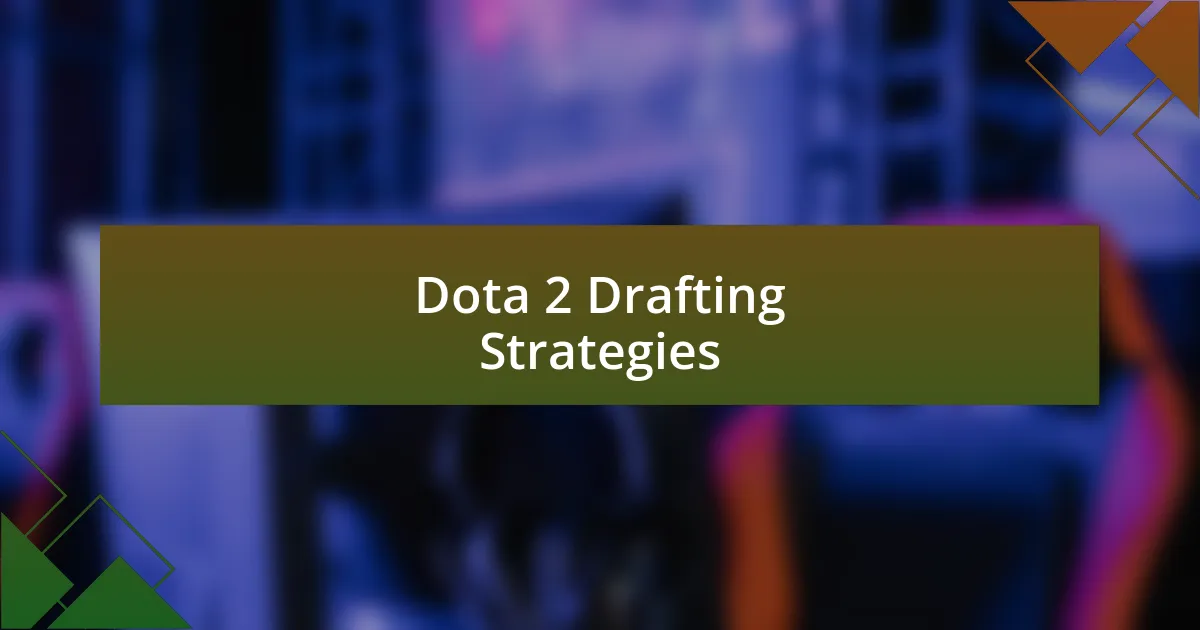
Dota 2 Drafting Strategies
Dota 2 Drafting Strategies Overview
Dota 2 drafting strategies encompass the methods and approaches used by teams during the hero selection stage of the game. Effective drafting can significantly influence the outcome of the match. It involves selecting heroes that complement each other, counter the opponent’s picks, and suit the team’s overall strategy. Understanding hero synergies, meta trends, and positional roles is essential for a successful draft. A well-executed draft aligns with a team’s strengths while addressing weaknesses in the opposing lineup.
Understanding Hero Synergies
Hero synergies refer to the interactions between selected heroes that enhance team performance. Some heroes have abilities that work well together, providing powerful combinations. For example, heroes that can initiate team fights paired with those that can deal massive area damage create formidable strategies. Analyzing synergies helps teams maximize their impact in team fights and objectives. Recognizing these combinations can create opportunities and dictate the flow of the game.
Counter-Picking Strategies
Counter-picking involves selecting heroes specifically to exploit the weaknesses of the opponent’s chosen heroes. Each hero in Dota 2 has strengths and vulnerabilities. By selecting heroes that counter the opponent’s picks, a team can negate their effectiveness. For instance, if the enemy picks a strong melee carry, selecting heroes with crowd control abilities or strong ranged damage can significantly hinder their early game potential. An understanding of hero matchups is crucial for effective counter-picking.
Positioning and Role Drafting
Positioning and role drafting emphasizes the necessity of assigning roles based on each hero’s strengths and positioning in the game. In Dota 2, heroes typically fit into specific roles: carry, support, offlaner, etc. Identifying which heroes fit these roles ensures a balanced composition. A clear distribution of roles facilitates effective team strategy and execution during matches. Teams should focus on versatility so that heroes can adapt to different circumstances during the drafting phase.
Adapting to Meta Trends
Adapting to meta trends is critical in Dota 2 drafting. The meta refers to the current state of the game, highlighting the most effective heroes and strategies employed at a given time. Keeping track of occasional shifts in the meta allows teams to draft heroes that are currently strong. This adaptability ensures that a team can utilize the best available options and surprise opponents with unexpected picks. Understanding the evolving landscape of hero strengths and weaknesses is key to successful drafting.
What are the key components of Dota 2 drafting strategies?
The key components of Dota 2 drafting strategies include hero selection, team composition, counter-picking, and synergy. Effective drafting requires selecting heroes that not only suit the team’s playstyle but also counter the opponents’ selections. For example, a balanced team composition typically features a mix of damage dealers, support heroes, and initiators, ensuring versatility in gameplay. Additionally, understanding meta trends can influence hero choices, as certain heroes may be stronger in specific patches.
How does counter-picking work in Dota 2?
Counter-picking in Dota 2 involves selecting heroes that exploit the weaknesses of the opposing team’s picks. For instance, if the enemy selects a melee carry, picking heroes that can disable or kite them, like Phantom Lancer, can be effective. This tactic often occurs in the second phase of the draft when teams can adjust their picks based on what their opponents have chosen. The effectiveness of counter-picking is supported by statistical win rates of heroes against others in competitive play.
Where can teams find information about current meta heroes for drafting?
Teams can find information about current meta heroes for drafting on websites such as Dotabuff, OP.GG, and Liquipedia. These platforms provide statistics on hero win rates, pick rates, and performance in various patches. Following professional tournaments and analyzing draft strategies from high-level games on platforms like Twitch and YouTube also helps teams stay updated on viable picks.
When should teams prioritize picking certain roles during the draft?
Teams should prioritize picking certain roles during the draft based on their desired team composition and the heroes available. Typically, it’s important to secure core heroes early to ensure the team has access to strong damage dealers. This is often done in the first phase of the draft. Prioritizing support heroes later allows teams to react to opponents’ picks, ensuring effective counter-strategies. Observing professional matches reveals that this timing can significantly impact a team’s overall effectiveness in the game.
Who typically leads the drafting process in a Dota 2 team?
The drafting process in a Dota 2 team is typically led by the team captain or the designated drafter. This person is responsible for making strategic decisions based on the team’s overall plan, individual player strengths, and the current meta. Studies of successful Dota 2 teams show that coherent drafting leadership correlates with improved performance, underlining the importance of this role in competitive play.





